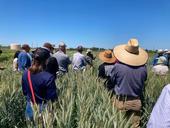- Author: Mark E Lundy

2024 UC Davis Small Grains and Alfalfa Field Day
May 9th, 7:30 a.m. – 1:30 p.m.
Supported by the California Crop Improvement Association (CCIA)
REGISTER HERE (no charge for event)
Department of Plant Sciences Field Facility, UC Davis
(
- Author: Mark E Lundy

Please mark your calendars for a May 9th, 2024 field day at the UC Davis Department of Plant Sciences Field Facility. Program will start in the morning and include lunch with presentations on small grain variety development and agronomic management of small grain crops. Full details and registration will be posted on the UC Small Grains Blog closer to the date. We hope to see you there!
- Author: Mark E Lundy
- Author: Nicholas E Clark

UC COOPERATIVE EXTENSION FIELD DAY
Cool Season Cropping Systems in the San Joaquin Valley
4/18/2024
9:45 AM – 12:30 PM
Location: Westside Research and Extension Center
17353 W Oakland Ave, Five Points, CA 93624
CEU (available):
CCA: 0.5 SWM, 0.5 IPM, & 1.0 CM
- Author: Mark E Lundy

Please mark your calendars for April 18th for a field day at the UC Westside Research and Extension Center starting at 10AM. Topics will include deficit irrigation approaches to small grain management and small grain variety development. Full details and registration will be posted on the UC Small Grains Blog closer to the date. We hope to see you there!
- Author: Mark E Lundy
- Author: Micah Levinson
- Contributor: Karla Estrada
- Contributor: Joshua Hegarty
- View More...

Preliminary grain and forage yield results for our fall-planted common wheat, triticale, durum wheat and barley trials are now available on the UC Small Grains Research and Information Center website:
https://smallgrains.ucdavis.edu/Annual_Variety_Results/2023
The results are preliminary and may change as samples and data are analyzed further. Final/complete results will be available in 6 to 8 weeks.
We appreciate the contributions of collaborators who helped make this year's trial possible!



